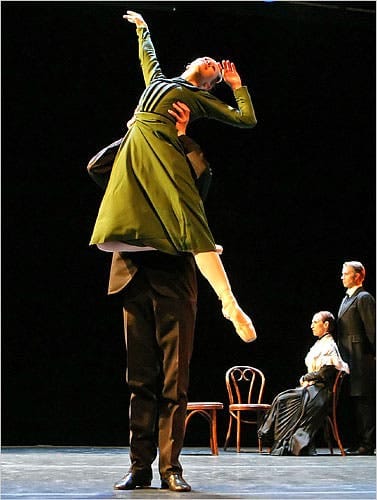Anniversary Party

"Dance/Speak: The Life of Agnes De Mille"
New York Theatre Ballet
Florence Gould Hall
New York, NY
April 17, 2009
The small and innovative company celebrated its 30th anniversary Broadway style, with a play about the life of the American choreographer Agnes de Mille. There was plenty of dancing, carefully reproduced and immaculately rehearsed, but the acerbic, fierce, independent spirit of de Mille was front and center. The work was written by the novelist Anderson Ferrell, a former dancer and close associate of de Mille in her later years. It summarized her life, quoting liberally from her own writings, as if she were telling it during the 1977 performance, when she returned to the stage after a crippling stroke in 1975. The actor Patricia Conolly (who thanked her wig maker) was sharp, witty, and theatrical--very like the films of de Mille's interviews.
This was pure pleasure for anyone who has read de Mille's autobiographies, though it might be confusing for audience members less familiar with the dance scene in the 1930's, and there was at times a feeling of in crowd gossip. I am not sure that everyone in the audience could make sense of a woman with a strange accent called Mim going on about how beautiful Alicia was and how unbelievably lazy Freddy was turning out to be. Even the frequent references to Uncle Cecil and the dance scene in "Cleopatra", with Claudette being difficult about the costumes, was probably ancient Egyptian to many.
But there was some truly revelatory moments, when the dances seemed to emerge from the feelings she was describing, none more potent than her description of her shock and pain at her parent's divorce, followed by a scene from "Fall River Legend" where Lizzie is seen sitting in agony between her father and her stepmother. It was certainly not a stretch to see that de Mille's feelings were part of her creation of Lizzie, and there was no sense of sensationalizing the connection. This was no cheesy biopic docudrama of an artist's life; anyone who has seen Eifman's take on Balanchine, Tchaikovsky, or poor Olga Spessivtzeva knows what an easy trap that is to fall into. It was certainly clear that the homely cowgirl in "Rodeo" has much of de Mille in her (and indeed she was a constant ghost throughout "Dance/Speak"), but the play has enriched at least my understanding of "Fall River Legend".
So to did the use of the "Funeral Dance" from "Brigadoon" to accompany de Mille's description of the loss of her close friend Ramon Reed. But de Mille's famous integration of her Broadway dances into the fabric of the show makes it a bit difficult to excerpt them, and much of her choreography does not really have the formal structure to stand on its own. Of the extended Broadway samples, Oklahoma's "Dream Ballet" worked best, in large part because it was prefaced by a detailed excerpt from her writings explaining her intent. The excerpt from "Carousel" was also effective because many were familiar with the words and music, but the dances from "One Touch of Venus" and "Goldilocks" made it a long evening.
Unfortunately, with the exception of Elena Zahlmann, who was outstanding, none of the other dancers were identified. Besides Zahlmann, the other dancers in the evergreen comedy "Three Virgins and a Devil" certainly deserve credit, and the "Sword Dance" from "Brigadoon" was thrilling. The actors, too, many playing several parts, had no weak links, and were funny, touching, and pithy. It was a fascinating and moving work about a fascinating, and I expect often infuriating, but indomitable lady.
copyright © 2009 by Mary Cargill



